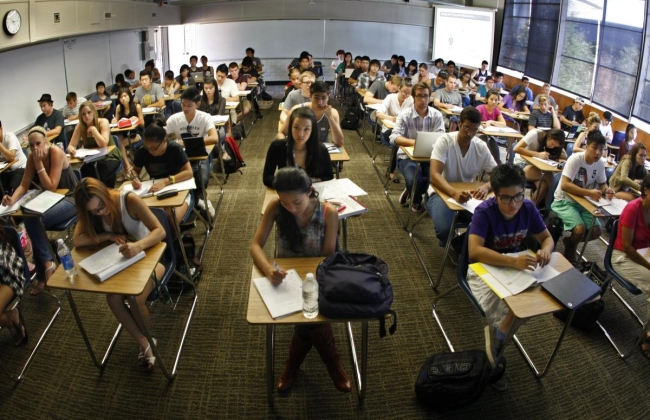You have /5 articles left.
Sign up for a free account or log in.

The reasons for students leaving college without a degree remain largely the same but were multiplied by the pandemic: job and family obligations and financial issues.
Don Barletti/Los Angeles Times/Getty Images
The number of students in the United States who have attended college but left before receiving a credential, certificate or degree has risen to 39 million, from 36 million in 2019, according to a new report released Tuesday. Black and Hispanic students continued to make up of disproportionate share of the total number.
The report, “Some College, No Credential,” by the National Student Clearinghouse Research Center, follows similar reports from the center in 2019 and 2014. The total number of uncredentialed students reported represents an 8.6 percent increase and partly reflects the impact of the COVID-19 pandemic on the academic outcomes of college students who faced unprecedented financial and personal challenges, including job and income losses and the sickness and deaths of family members.
The report covers the 2019–20 and 2020–21 academic years, in all 50 states, the District of Columbia and all U.S. territories. Only Nebraska and Connecticut did not experience an increase of students stopping out. In those states, 0.1 percent and 0.3 percent fewer students left college than in 2019, respectively,
The percentages of Black and Hispanic students who left college without credentials or degrees remained lower than their percentages enrolled in college—combined, they made up 42.8 percent of the 39 million who left college, compared to 34.3 percent of the total undergraduate enrollment nationally.
Others who have studied and recognized the racial imbalance in the number of students leaving college without credentials have offered recommendations for reducing the rates based on previous studies by the clearinghouse. The “Degrees When Due” initiative from the Institute for Higher Education Policy is among those efforts. It advocates for more institutional support for returning students and for increased government funding for the colleges and universities that serve them. Other efforts include making community college free for returning students who are close to earning a credential or degree and offering bachelor’s degrees through community colleges.
Panelists who spoke during a Tuesday webinar on the report noted that getting Black and Hispanic students, as well as Indigenous and first-generation students, back to college and on track for completion is essential to decreasing the overall number of students who left college without a credential.
“Supporting students of color is our core mission as an HBCU,” said Nick Vaught, Morgan State University’s assistant dean for academics and student success, who was instrumental in developing the new College of Interdisciplinary and Continuing Studies, which began offering courses this semester at the historically Black college in Baltimore. He said besides offering reduced tuition and fees and expanded undergraduate and graduate courses for returning students, the program will keep classes small and ensure students frequently interact personally with faculty, staff and administrators.
Vaught said the goal is for students to “have someone to talk to, someone who’s on their side during their entire matriculation process.”
Patricia Erjavec, president of Pueblo Community College in Colorado, echoed similar goals for students enrolled at her institution, 35 percent of whom are Hispanic and 60 percent of whom are first-generation students. The college has a program called Trio that emphasizes hands-on interaction with those students.
“There isn’t anybody at the institution that doesn’t make themselves available to our students so they can get the resources they need, so they feel comfortable, so they don’t feel like they don’t have what it takes to be successful,” she said. Her goal is to eventually “model our entire college” after that program.
Patricia Steele, president of the research company Higher Ed Insight, referred to her organization’s study on students’ return to college, released in January, and its findings on the various factors that interrupt or derail students from completing college, such as work, raising a family and navigating financial hardships such as those brought on by the pandemic.
“College was fitting in between life for them,” Steele said, adding that institutions have to be more flexible about working around returning students’ lives. She also cited obstacles such as credit transfers, transcript holds and other bureaucratic problems.
“We have to really think radically about how to make the process easier for students. I think that’s where the conversation really has to begin,” she said.
The Higher Ed Insight study revealed that the unique problems affecting individual racial groups were not going to be solved with blanket solutions, Steele said.
“We wanted to stress that it’s not a one-size-fits-all for each of these populations,” she said, pointing out, for instance, that Black and Latino students largely had different reasons for leaving college and for considering returning.
With the number of students leaving college without credentials rising and the racial imbalance unchanging, Courtney Brown, Lumina’s vice president of strategic impact and the panel moderator, said, “We’ve got to change the trajectory of that 39 million. This is an emergency—urgent.”








